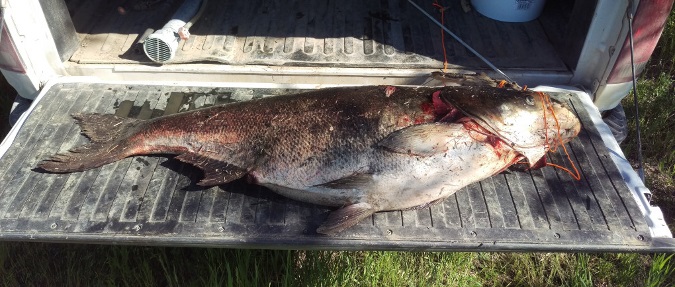A bow angler fishing in a private gravel pit near Redwood Falls Sunday caught the largest invasive carp recorded in Minnesota. The bighead carp measured 47 1/2 inches in length and weighed 61.7 pounds.

Invasive fish coordinator Nick Frohnauer said the angler immediately reported the capture to the Minnesota Department of Natural Resources and was helpful getting the specimen delivered to the area fisheries office. “The news of this capture is somewhat alarming, given the size and location,” Frohnauer said. “This bighead carp was captured about 80 miles upstream from the only other bighead carp captured in the Minnesota River.”
The fish likely entered the gravel pit during a period of high water. The pit is within the Minnesota River floodplain and periodically becomes connected during flood flows. When floodplain lakes become connected to the river, fish move into these areas to escape the high water velocities in the main river and exploit new food sources.
“The gravel pit where the carp was captured provides a unique opportunity to determine if the fish was an isolated capture or part of a group,” Frohnauer said. “The pit is off the main channel, so fish are confined to a smaller area rather than having many miles of river.”
The DNR invasive carp field crew is working with the local fisheries office and the landowner to conduct follow-up sampling. The crew will also look at sampling areas near the location, including floodplain lakes and the main river.
The DNR is concerned about the potential impacts of invasive carp in the Minnesota River and other waters. The agency is working with other state and federal agencies, conservation groups, university researchers and commercial businesses to prevent the spread of invasive carp.
• The DNR has contracted with the Water Resources Center at Minnesota State University – Mankato to provide information to guide DNR management decisions for the Minnesota River.
• The Minnesota Aquatic Invasive Species Research Center at the University of Minnesota has funding through the DNR to evaluate potential deterrents for Mississippi River Locks and Dams. Through the Environment and Natural Resources Trust Fund (ENTRF), they have installed acoustic speakers at Lock 8 in southeastern Minnesota and modeled flows through the gates at Dams 2, near Hastings, and 8.
• The DNR is in the process of awarding a contract to explore the feasibility of installing an acoustic deterrent system at Lock and Dam 5 in southeastern Minnesota. A deterrent system at this location would help prevent fish from moving into both the Minnesota and St. Croix rivers.
Invasive carp have been progressing upstream since escaping into the Mississippi River in the 1970s. These large fish compete with native species and pose a threat to rivers and lakes. While no breeding populations have been detected in Minnesota waters, individual fish have been caught in the Mississippi near the Twin Cities, the St. Croix River and the Minnesota River.
Invasive carp captures must be reported to the DNR immediately. Call 651-587-2781 or email invasivecarp.dnr@state.mn.us. Take a photo and transport the carp to the nearest fisheries office or make arrangements for it to be picked up by a DNR official.
More information about invasive carp is available at mndnr.gov/invasivecarp.
